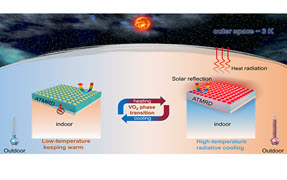Paving the way for carbon nanotube integrated circuits
Rapid increases in computer processing power over the past 40 years have been driven by the steadily decreasing size of metal oxide semiconductor field-effect transistors (MOSFETs). These comprise a n-type conductor, with negative electrons as the major charge carrier, joined to a p-type conductor, with positive ‘holes’ as the major charge carrier.
But the MOSFET will soon reach its technological and fundamental physical limits 1. This is leading researchers to look for alternative technologies, with semiconducting carbon nanotubes (CNTs) now considered to be one of the most promising building blocks for future nanoelectronic devices2.
Since the first CNT field effect transistor (CNTFET) was designed in 1998 3, device performance has continually improved. By using palladium (Pd) electrodes and high-k materials (which are less prone to current leakage) as gate dielectrics, p-type CNTFETs have now surpassed the capabilities of state-of-the-art silicon p-MOSFETs 4.
However, the development of n-type CNTFETs has lagged behind. This is mainly due to the difficulty of fabricating a type of junction known as an ohmic contact or Schottky barrier-free contact between metal electrodes and the conduction band of the CNT. The slow progress in producing n-CNTFETs has greatly hindered the development of CNT-based integrated circuits.


We recently discovered that scandium (Sc) can be used to generate an ohmic contact with the conduction band of a CNT 5. This is because Sc has a very low work function (the energy required to remove an electron; ∼3.3eV) and forms a good physical contact with the CNT (see Figure 1a). As a result, there is good alignment between Sc and the conduction band edge of the CNT, producing an ohmic contact (see Figure 1). So, both a high on-state current and a high on/off ratio can be obtained simultaneously. In addition, this approach has a better stability in air than those previously reported by other research groups.
By combining this new n-CNTFET, which can transport electrons very efficiently via a process known as ballistic transport, with a previously developed ballistic p-CNTFET, we have produced a doping-free CNT-based ballistic CMOS (complimentary metal-oxide-semiconductor) technology5. We have already demonstrated the feasibility of this technology by fabricating a simple complementary inverter. This involved forming a contact between an intrinsic CNT and two Pd and two Sc electrodes without any intentional doping (see Figure 2). In principle, much more complicated CMOS circuits could be integrated with CNTs placed on any suitable insulator substrate with top-gate geometry and high-k dielectrics.
An important feature of our CNT-based doping-free CMOS technology is that it simply requires patterned arrays of semiconducting CNTs with moderately narrow diameter ranges, such as 1.6–2.4 nm, rather than CNTs with a defined chirality (alignment of the carbon bonds in the tube). These CNT arrays are within the reach of current nanotechnology techniques and could lead to the development of CNT-based CMOS devices with increasing complexity. To this end, we are now developing logic circuits based on this technology.
This work was supported by the Chinese Ministry of Science and Technology (grants 2006CB932401 and 2006CB932402) and the National Science Foundation of China (grants 60571002, 10434010, 90606026).



